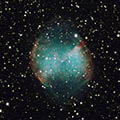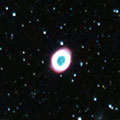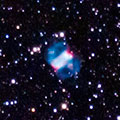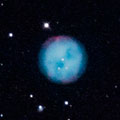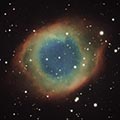Planetary Nebulae Photo Gallery
A planetary nebula is an expanding shell of ionized gas surrounding a star late in its life. Most stars between 0.8 and <10 solar masses eventually exhaust their hydrogen fuel and expand enormously to become cool red giants. At this stage, a star begins to convert helium into carbon and oxygen. Heleium fusion is a very temperature sensitive process that causes the star to expand and contract over short time scales.
These pulsations can grow large enough for the star to eject its entire atmosphere into space. The expanding cloud of gas surrounds the exposed and extremely hot core of the star. The ultraviolet radiation from the core ionizes the expanding shell causing it to glow as a planetary nebula.
The lifetime of a planetary nebula is quite short (10,000 years) compared to the lifetime of the star (billions of years) producing it. The typical planetary nebula is about one light year in diameter. There are about 3000 known planetary nebulae in the Milky Way galaxy.
The 18th-century French astronomer Charles Messier recorded 4 planetary nebulae in his Messier Catalog of deep sky objects. See Wikipedia for a good article about planetary nebulae.
Click on each thumbnail to see a larger image.
